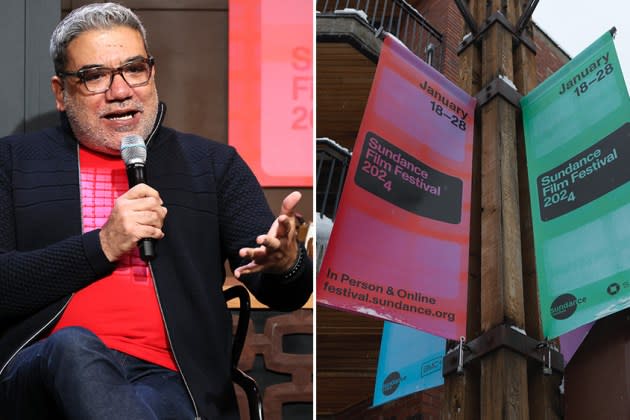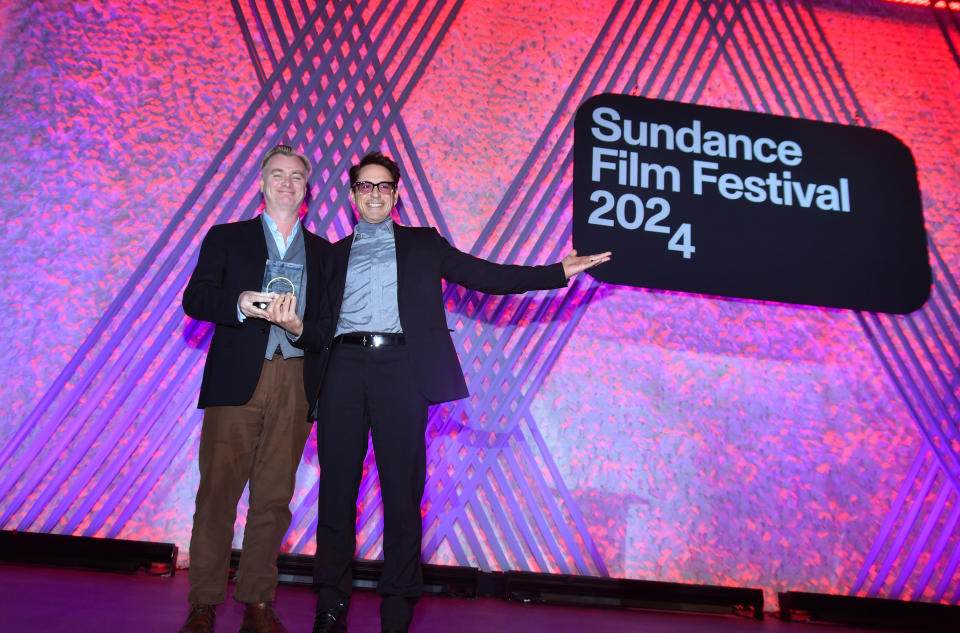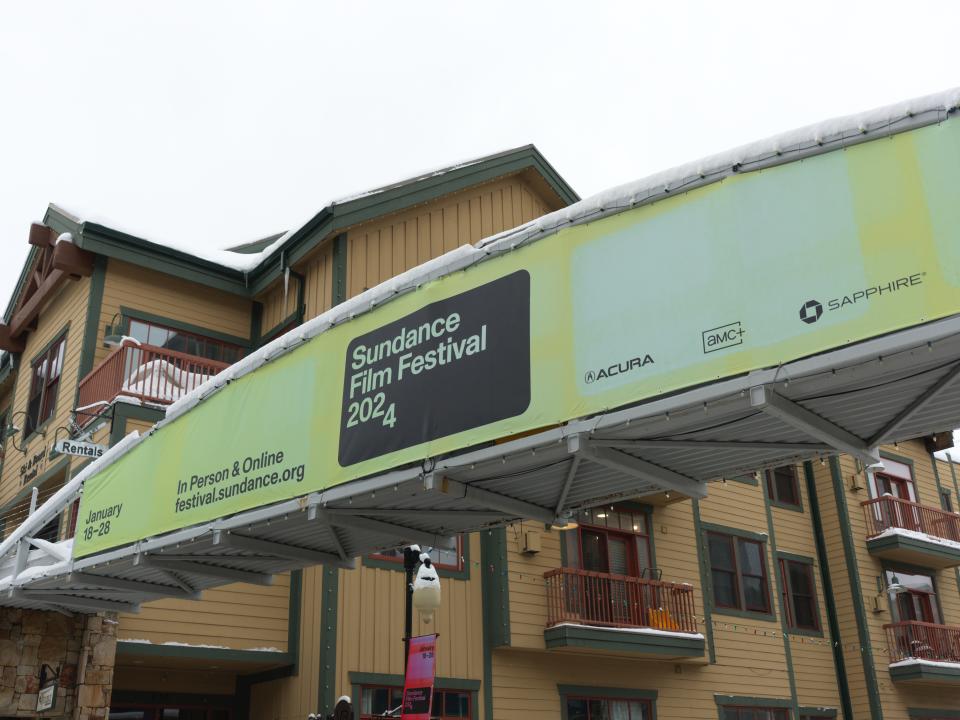New Sundance Director Eugene Hernandez Breaks Down How Changes To Festival Played Out This Year – The Deadline Q&A

The Sundance Film Festival wrapped Sunday with some big sales in a challenging indie film landscape with distributors in need of content. New at the 40th edition, the second post-Covid and led for the first time by director Eugene Hernandez: a kickoff event with Jason Blum, 19 films on opening day, a narrower digital footprint, and fewer features as Hernandez focuses on “first impressions” and “giving each of our invited films and filmmakers the celebratory, unforgettable introduction they deserve.” Cost and staffing considerations were also at play.
Meanwhile, Sundance is about to start renewal talks with longtime host Park City, a conversation that comes around every seven years. Hernandez, the longtime New York Film Festival director and IndieWire co-founder, who also heads year-round public programming for the Sundance Institute, talked with Deadline about his inaugural run in snowy Utah.
More from Deadline
Sundance Film Festival 2024: All Of Deadline’s Movie Reviews
Sundance Film Festival 2024 Photos: Award Ceremony, Film Premieres & Parties Gallery
The Black List & Amazon MGM Name Audrey Rosenberg Their Final Open Feature Script Deal Recipient
(The Q&A was edited and condensed for clarity.)
DEADLINE: Can you talk about changes this year, starting with a very different opening day, including an appearance by Blumhouse CEO Jason Blum?
EUGENE HERNANDEZ: I’m going to go a little broader on this and then speak to the specific question. We really tried to rethink how we kicked off the festival this year. Back in the early days when I first started attending, there was a singular opening-night film, and that was actually in Salt Lake City. In subsequent years, there were a handful of day-one films, and they would play a new film in each venue. This year, in the redesign of the model, on day one we made some significant for Sundance changes and we started screenings at noon, and we premiered 19 films — 19 world premieres. And I think that’s important because we really wanted the focus to be on the slate of films from the start. We wanted to make sure we pushed that message out to the industry — to arrive early, get there on Wednesday night, have dinner with friends, and be ready to go Thursday morning. So not having a singular opening-night film, but having this whole slate of films.

And talking with the team, and talking at a board retreat back in October at the Sundance Resort — Jason is one of the members of our board and has a long history with the festival — about plans to kick off the festival, we came up with this idea. We didn’t even call it a press conference, we called it the Sundance Scoop … a conversation with Jason [and Hernandez, Sundance Institute CEO Joana Vicente and programming head Kim Yutani] to set the tone and open this year’s festival. [Blum said at the event he hopes Sundance films wind up in theaters and should with the 2024 release schedule “decimated.”]
When I started going to Sundance, [founder] Robert Redford would do a lunch with filmmakers at the Sundance Resort and a press conference there. He effectively announced he was kind of taking a step back from Sundance [in 2019]. Coming out the pandemic, we thought, how do we reshape this moment? We did this event with Jason. And on Saturday, we hosted a brunch for all of the filmmakers up at the Sundance Resort, and Amy Redford gave keynote remarks on behalf of her dad and family, and she read a statement that her dad shared.
[It read: “Welcome to this mountain. We want you to not only see this place, but perhaps even feel it … Continue to perservere. Bring your voice, your vision, your point of view about the world you are living in. This is about your work, and getting it seen, and we thank you for sharing it with us.”]
As for the future, I can’t speak to that yet. We’ll be talking about how we want to open next year’s festival.
DEADLINE: Another change we noticed is that the Eccles Theater, for instance, wasn’t programmed for the full week. And the Midnight section films played earlier than midnight.
HERNANDEZ: We evolved the footprint of the festival this year to be as responsible, and in consideration of not only cost — of course that is something you always keep in mind — but also the impact on and workload of our staff. It’s a heavy lift. We have thousands of volunteers, some local, some travel from all over the country every year. It’s a heavy load to be out in the snow and the cold as many hours a day as our teams are to pull off this festival. So when we really looked at how the festival could have the best and most meaningful impact — and since we had made the decision to give each film its premiere, its press and industry screening, and a follow-up screening in Park City before Tuesday — we realized we could and should adjust the physical footprint of the festival in the second half. And so what you saw is a more intimate experience. The center part of the festival is devoted to our artists and our alumni, and the final weekend is about the award winners, elevating those films, so it made more sense to really embrace the intimacy of the experience by using and focusing on the venues that could really support that vibe. We also tried to be responsible to both the bottom line and also to our staff and our teams, evaluating where we needed the venues to happen and when. So because everything premiered by Tuesday, it made sense to keep those venues active through Tuesday and then, as we moved into the final two chapters of the festival, we could adjust accordingly.
Eccles is the festival’s biggest venue with 1,200 seats.
On the Midnight section, it’s a heavy lift for our teams to be on call and on the front lines until two or three in the morning and back to work the next morning for a 9 a.m. screening. It’s a big ask.
Of course, again, the thing to keep in mind with all of this is we’re going to be evaluating it. We’re taking feedback from the artists, from the industry, from the volunteers. We’ll evaluate it and then make decisions for next year very soon. We’re already talking about it.
RELATED: Sundance Film Festival Awards: ‘In The Summers’, ‘Dìdi’, ‘Daughters’ Top Winners List
DEADLINE: What changed in the festival’s virtual component?
HERNANDEZ: Our industry friends have been vocal and given us a lot of feedback and that’s how we shaped this year’s digital footprint. With 90-plus features, and 50-plus shorts, I think it gives more people more time to catch up with those films. Last year, all the films in the festival were required to have digital screenings, and they started earlier. So you had films premiering into the first half of the festival and you were moving immediately into the digital, with a larger program of films. This year, only competition films were required to be on the platform, although others could opt in and ask to be included. It was a more limited, narrower window. In broad strokes, last year was more films streaming earlier on the platform and for a bigger audience.
This year, in prioritizing that first impression and assuring that every film had an in-person premiere, a P&I screening, and a follow-up screening in Park City by Tuesday, we were really trying to leverage the in-person experience as a launchpad for everything that would follow, including the awards announced on Friday. Then people could catch some of the winners on the platform for a couple of days with a limited number of streams. Then, the films go out into the world, head to other festivals and all that.
We tried to create a distance between the premiere and the digital.
We tried to think about digital this year as an additional screening in an additional venue. Just like any screening where you have a finite number of seats.
Something we take really seriously is how to be part of helping each and every film and filmmaker have the best possible launch they can have. Because films are coming to the festival brand new and fresh for an audience. Whether that’s the industry who are seeing it for the first time right alongside press, right alongside other artists who are in the room, curators from around the world, our local audiences. Everyone is watching the movie for the first time. And that’s a rare experience at only certain festivals in the world. And in this case, it’s a festival and an experience that’s reserved primarily for first- or second-time, early emerging artists, with just a handful of established folks sprinkled in.
DEADLINE: Sundance had a record 17,400+ submissions this year. Two questions: What are your thoughts on the lineup? And was it was impacted by the strike?
HERNANDEZ: I feel we had such a strong program that was as vital and bold and ambitious as the kinds of films I saw at Sundance when I started going in the early ’90s. But I think, as with any year, the industry will react and respond to those films that they feel they can find an audience for. Some of the films have already been acquired, some will announce deals in the coming days. And others will take a slower approach. There are films from Sundance that are going to Berlin. There are films that will going to other festivals and will find their audience in a different way, or it might take a little bit longer.
I feel like the industry has always grappled with commerciality around Sundance. And I think that’s inherent in Mr. Redford’s creation of the Sundance Institute to begin with. [It] was always outside of the mainstream Hollywood industry. I’m just relieved that so many films are already finding homes so quickly. And I think we are going to continue to see that other films might take a slightly slower approach, but I think they will also find a home.
[Deals include: Netflix landing worldwide rights to It’s What’s Inside, the thriller written and directed by Greg Jardin, for $17 million. The streamer also acquired docs Ibelin and Skywalkers: A Love Story. Jesse Eisenberg-directed A Real Pain sold to Searchlight for $10 million. Amazon MGM nabbed My Old Ass for $15+ million. In a deal that when closed will also be worth $15 million, Warner Bros. is the frontrunner to land doc Super/Man: The Christopher Reeve Story. Neon acquired Steven Soderbergh’s ghostly Presence. Sony Pictures Classics boarded Kneecap, a doc about an Irish rap trio.]
DEADLINE: And the impact of Hollywood strikes last year?
HERNANDEZ: That’s the big question for us. We don’t know what we didn’t see, and whether there’s a backlog of films that needed to sort of navigate last summer, and will get finished [or not]. We’re going to be watching closely how the numbers shape up for next year, of course. But to have a record number of submissions this year, a historic number for this festival, even with the strikes, was certainly eye opening for us.
We did see an increase in submissions internationally.
DEADLINE: The strike led to some tight timelines as filmmakers granted interim agreements pushed up against the festival deadline, like Alex Thompson and Kelly O’Sullivan’s Ghostlight (which sold to IFC Films and Sapan Studios) and Sean Wang’s Audience Award-winner Dìdi.
HERNANDEZ: Those are just two examples of filmmakers that sort of self-identified their situation. I am sure more will be talking about that as we go forward. We only saw what was submitted, we didn’t see what wasn’t ready. But that is what we are watching for this year, and probably what our colleagues from other festivals will be watching. What did SXSW see? What will the summer festivals find? What will the fall festivals — Toronto, Telluride, New York — what will they find? It’s something we’re watching really closely.
DEADLINE: There’s chatter around the negotiation with Park City. Can you address that?
HERNANDEZ: Obviously I’m new to this role. I’ve been here a little over a year. I know that every few years there’s a renegotiation and conversation around the agreement between the festival and Park City, so we happen to be in a year where we are about to dig into that conversation. As a former journalist who used to attend the festival, I was always asking those same questions back when I started. Now that I see it from this new vantage point, I feel like there’s a kind of continuity here. There’s a regular conversation that happens in Park City [circa every seven years] about the relationship between the city and the festival. And that conversation happens this year.
During the festival the city held an outdoor celebration to celebrate its 40th edition. Cookies, hot chocolate, music, some really amazing Indigenous performers and speeches and there was just so much love that we felt from the city towards the festival and back. It just reminds me on a personal note how special the relationship has been over the years. It’s a longstanding relationship.

DEADLINE: What was happening in Salt Lake City this year?
HERNANDEZ: We refined the footprint. We have a relationship with the Salt Lake City Film Society and its Broadway arthouse theater. And there’s another venue around the corner, the megaplex at the Gateway. And we added the Rose Wagner Center as a screening venue; Super/Man: The Christopher Reeve Story premiered there. We want to make sure that we are showing up where audiences are already showing up year round. It’s really rewarding now with the festival over to see that the response was so strong in both cities.
Our artists do go back and forth. There are a lot of college students, and it’s a local audience and it’s a very responsive audience. We saw that night after night with sold-out shows throughout the week, adding screenings to meet demand.
It’s a marathon. It’s not just the first few days that we focus on, on the industry side, but it’s the full experience that we as an institute focus on in giving Utah and our local audiences the opportunity to engage with the films, and the conversations, and meeting the artists.
Best of Deadline
2024 Premiere Dates For New & Returning Series On Broadcast, Cable & Streaming
Hollywood & Media Deaths In 2024: Photo Gallery & Obituaries
Sign up for Deadline's Newsletter. For the latest news, follow us on Facebook, Twitter, and Instagram.


